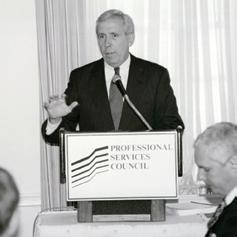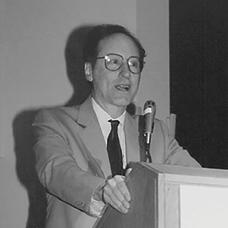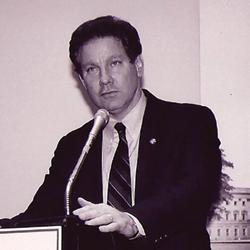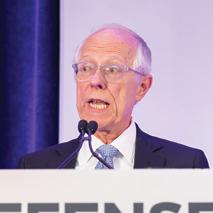
30 minute read
President’s Letter
Welcome to this very special edition of Service Contractor, commemorating 50 years of PSC. As we look back on 2022, it somehow seems fitting that the year had both challenges and surprises for government contractors. PSC worked with our members and industry to address delays in many areas: in Congress providing funds, in agencies obligating those funds, in awarding contracts on schedule, and in finding and keeping enough great workers. One area where there was no delay was in the rising cost of inflation.
Through it all, PSC continued to meet and collaborate with many federal agencies, including quarterly meetings with each of the FAR council principals (GSA, NASA, DoD, and the Office of Federal Procurement Policy in the White House). We submitted dozens of formal comments on proposed rules and pending regulations, and some of those comments had real impact. We worked closely with Congress to support good ideas and resist bad ones. The PSC bill tracker in this magazine highlights the status and major actions of key bills on the Hill.
This year also saw a return to in-person PSC conferences. The PSC Annual Conference and our half-day conferences were all widely attended with great government speakers and content. Coming events in 2023 will let us gather, network, and find solutions to the industry’s challenges.
For 50 years, PSC has been serving the government contractor industry, advocating for contractors, improving industrygovernment relations, and bettering the process of doing business with the government. In the feature article of this issue, I invite you to join me in a little journey down memory lane to show where we’ve been and all of the important work remaining. 2023 brings divided government with Republicans and Democrats split in Congress. This is not rare; for nearly 30 of the past 42 years, PSC will urge the White House and agencies to focus on implementation and execution of existing programs through using available funds to improve government through better, more timely contracts. The funding is there, the work needs to be done. Their best hope to move forward is to solicit, evaluate, award, and let you perform.
We will continue to be the voice of reason on the Hill, with the agencies, and in the news media. We will continue to communicate all of that to you and with you.
Here is our promise to you. You have a great team at PSC, working for you and with you. We aim to be your best advocate against these challenges and surprises. With your support and engagement on the issues and possible solutions, we will continue to see some real successes.
In closing, it is such a privilege working on behalf of this industry. The future of America depends on a government that we can trust, a government that performs better, and the best way to have that is to take better advantage of all that government contractors have to offer. We will continue every day to help you make that happen.
We wish you and yours a healthy and prosperous new year in 2023.
David J. Berteau, President and CEO

PSC 50 Years and the Future Focus
When PSC began 50 years ago, our sector was largely unknown as part of US economy. Half a century later, PSC has helped make our industry one of the most prominent and high impact forces affecting the lives of Americans across the entire federal government.

The Birth of the Organization
In the late 1960s, Dr. Robert Krueger (then CEO of the government services contractor PRC) undertook research into companies doing work similar in nature to PRC, adopting the term ”professional services.” The study identified 1500 professional services firms in an industry that was growing at twice the rate of the rest of the economy.
Krueger realized that one value of the research was identifying possible allies to join with PRD in battling common problems. To this end, in 1970, Kruger wrote to some of those companies on two issues: the government’s tendency to bring in-house work that could be done well by private-sector for-profit companies and the preferential treatment given to nonprofit organizations, particularly Federally Funded Research and Development Centers (FFRDCs). More than half of the contacted organizations joined together to address these issues.
The new business allies began visiting Capitol Hill and members of the executive branch to further their causes of full and open competition and using contractors to improve government operations and performance. In 1972, the group incorporated as The National Council of Professional Services Firms in Free Enterprise (NCPSF), operating from PRC offices.
The Early Years
NCPSF took on both challenges. One early success led to an update of the Office of Management and Budget’s Circular A-76, the rules to be followed by the government before a decision can be made to keep work in-house.
The Council released a white paper to set forth its free market convictions, but sole-source contracts continued to be awarded to FFRDCs and other non-profit organizations. Council members felt strongly that they should be afforded the chance to compete on these contracts.
More broadly, procurement improvements were slow in the early 1970s. Through eight annual reports beginning in 1972, GAO (then named the General Accounting Office) offered recommendations from the congressionally-created Commission on Government Procurement Reform. GAO’s1979 final report noted that work on Commission recommendations was “far from complete, and momentum was slowing.”
The absence of top government attention to procurement, coupled with the fact that the Council had no paid staff and relied on contributions from a handful of firms to cover operating expenses, constrained success in the early years.
Early Successes
The mid 1970’s brought increased visibility to services contracts. The creation of the Office of Federal Procurement Policy (OFPP) opened possibilities for additional advocacy by the Council. One important achievement of this era was the rejection of the FEDNET proposal for a massive interlocking internal government data processing system that would have needlessly duplicated capability available from the private sector.
Advocacy Delivers
By the late 1970’s, NCPSF garnered increased attention and visibility for the industry through efforts led by BDM International’s CEO, Earle Williams. As more federal agencies pursued improved
H.R. 7674

performance at less cost through well-structured, competitive contracts with the private sector, Council member companies were expanding their focus to become government-wide.
One of the Council’s biggest accomplishments during the Williams era was the rejection of a labor union/IEEE-sponsored amendment to the Services Contract Act under which the U.S. Labor Department would set wages for all professional employees working on government contracts instead of using competition and private sector expertise to offer the best value for the government.
Industry-Killing “Reform”
The decade of the 1980s ushered in an era of change for the Council. A new charter changed the somewhat unwieldy name from the National Council of Professional Services Firms in Free Enterprise to the Professional Services Council. The Council appointed the Council’s first executive director, Virginia Littlejohn. Under her leadership, PSC’s reach expanded as the issues grew.
PSC faced a serious challenge, the proposed Consultant Reform Act of 1980. Introduced simultaneously in the House and Senate, this bill would have virtually eliminated the professional services contracting industry by requiring prior notice to Congress of every contract above $10,000 and forcing agencies to submit quarterly reports with the name and hours worked of every services contract worker.
The work of the Council helped ensure that the bill never came to a vote. It also focused PSC member attention on the lack of understanding in Congress and federal agencies of the need for and the real benefits of well-structured contracts and a fair and open procurement process. Today, enhancing that understanding remains a priority of PSC.
A New Administration Moves Forward
The Reagan administration from the beginning in 1981 sought to increase federal agency access to the talent and skill of the services contractor community. Its renewed focus on public-private competition under OMB Circular A-76 led to a dramatic increase of such actions.
PSC urged a level playing field, though the rules for such competitions strongly favored the government. For example, industry proposals needed to save more than 10 per cent over government costs, which did not include the same indirect costs and overhead burden as required in industry bids. Nevertheless, industry won roughly one third of all A-76 competitions.
Through these and numerous other actions focused on a fair marketplace and open competition, PSC expanded its voice and strengthened its advocacy on behalf of its growing membership.
Star Wars and Ross Perot
As programs, requirements, and funding grew for technical and professional services from contractors, PSC expanded its efforts. In the mid 1980’s, PSC reached its most visible FFRDC victory to date. The newly formed Strategic Defense Initiative sought to create a 500 person FFRDC to perform technical and management services. The need for speedy action and clear results helped as PSC fought vigorously against this plan. Through its efforts, the initiative was never proposed to Congress.
Also in the 1980s, faced with defense funding shortfalls late in the fiscal year, Deputy Secretary of Defense William Taft issued a freeze


H.R. 1670
on funds that supported all contract spending on services. This freeze remained in place until concerted industry efforts led to congressional action that addressed the shortfall and ended the freeze.
Sometimes the threats to the industry came not from Congress or federal agencies, but from other companies. For example, Perot Systems proposed a major sole-source contract with the United States Postal Service, a blatant abuse of fair and open competition. The Council and its members were unified and, faced with resistance from the entire industry, Perot Systems backed down.
As the industry grew, PSC played a key role in forming and sustaining broad coalitions of trade associations organized to promote open access to government markets and to deal with specific A-76 type issues.
One of the most significant industry victories of the decade came in 1987 with the creation and implementation of Standard Industrial Code (SIC) 87 for “Engineering, Accounting, Research, Management and Related Services”. PSC single-handedly worked with the Labor Department to develop and promote this category, formalizing the sector and its contribution to the United States economy.
“87 in ‘87!” became the rallying call for PSC. The new SIC legitimized professional services as far more than consultants and represented both a symbolic and substantive success.
The industry itself could visibly stand on its own. At the same time, PSC was becoming more visible as well. By the late 1980s, under President Mark Schultz, PSC became a free-standing organization, with its own office, full time director and staff. Its new-found capability would soon be needed.
The Acquisition Reform Era
Criticisms of and improvement efforts for the federal procurement system are as old as the nation itself. From the beginning in 1972, PSC has worked to have the government not only admit problems but do something about them. Opportunities for real reform seldom arise, but when they do, PSC has been ready.
Bert Concklin became PSC’s first president in 1990, just in time to lead PSC through a very productive decade.
With PSC’s strong support, the administration of President George H. W. Bush focused on better implementing ongoing initiatives, from the Packard Commission’s recommendations on acquisition reform to the SemaTech program to strengthen America’s semiconductor industry.
In 1993, President Clinton’s administration began with a commitment to “re-inventing” government. The new Administration focused on public-private sector partnerships, a commitment to exploiting the power of information technology, and a candid recognition that the federal acquisition system was in need of reform.
PSC began immediately to work with the Administration and its first OFPP Administrator, Steven Kelman, to achieve mutual objectives in promoting and supporting acquisition reform initiatives in the administration’s 1993 National Performance Review.
PSC also played a significant role in two major legislative triumphs that remain in force today.
The first, the Federal Acquisition Streamlining Act of 1995 (FASA), focused on best value contracting, eliminated duplicative statutes, and increased the potential use of commercial products and services and including a best-value policy. PSC’s role led to being invited to the Rose Garden Ceremony where the Act was signed.


The second, the Federal Acquisition Reform Act of 1996 (FARA), required government-wide Information Technology reform.
PSC had become a major player in federal acquisition reform efforts.
Together, the new legislation and the performance review recommendations opened new methods of procurement and access to the skills and capabilities of PSC member companies and all federal private sector contractors. Task order contracts and blanket purchasing agreements enabled agencies to move from requirements to contracts in weeks instead of years. PSC worked with agencies to create and make good use of these innovative contract vehicles, often providing input both to draft solicitations for the master contract as well as helping share best practices among agencies.
One such contract supported by PSC was the Army’s Logistics Civil Augmentation Program contract (known as LOGCAP). When U.S. military and allied forces deployed to the Balkans in the mid-1990s, LOGCAP enabled rapid delivery of results. This showed the way for more rapid acquisition and more effective results not just for defense but for all federal agencies across the spectrum of missions and functions.
The 1990s saw action in privatization of operations and functions that were previously government owned and operated. The Defense Department’s base closure process led to contracts to deliver technical and logistics services at closed bases from Indiana to Texas and California. PSC supported these actions, and PSC member companies contributed significantly to a process that enabled DoD to retain capability, save billions of dollars, and support a more diverse and resilient economy.
Beyond DoD, PSC supported studies and actions that reduced unneeded federal direct competition with the private sector, contradicting existing guidance and long-standing practice.
These dramatic post-Cold War initiatives and changes were supported and fostered by PSC from concept to fruition. They enabled government agencies to cut costs and save money, access systems and processes that were new and innovative, and deliver better results faster
PSC: 1997-2015
PSC was founded toward the end of the Vietnam War, grew and changed over decades of the Cold War, and matured following the collapse of the Soviet Union. Those were seen as momentous times, but the dawn of the 21st century were even more dramatic. PSC and the government contracting industry have participated actively in changes that have been transformative for our government, the nation, and the entire world. Here are some of the events and forces that have shaped, and continue to shape, the marketplace in which PSC members operate today.
PSC selected as its next president Stan Soloway, who had been one of the architects of many of those reforms during his time in the Pentagon during the Clinton administration. He was still in his first year leading PSC when the world turned upside down in one brief hour.
9/11
The terrorist attacks of September 11, 2001, changed everything, everywhere. Creating the Department of Homeland Security was the most significant government reorganization in a half-century. America undertook two major conflicts and worked to prepare for and guard against domestic threats. To meet all of these emerging needs, government contractors provided the surge capacity, flexibility, innovation, and technology the government needed. Congress

appropriated the necessary funding, including robust supplemental appropriations. The acquisition reforms of the 1990s opened new avenues of collaboration between the public and private sectors.
The demands of two wars required unprecedented levels of contractor support around the world, including development and reconstruction efforts simultaneously underway. Limited military protection meant an equally unprecedented need for private security for contractors themselves as well as for deployed personnel, including federal civilian employees,. PSC engaged and provided industry leadership on a broad array of issues from logistics and liability to prices and protests.
PSC worked with top levels of the Executive Branch, Congress, and the media, to ensure that the concerns and realities that member companies faced were widely considered and protected. Often, PSC was defending the government itself, for example at congressional hearings at which contracting officers and officials were targets. In addition, PSC partnered on “lessons learned” studies and testified before the Commission on Wartime Contracting and the Gansler Commission.
Many of the issues then are still on the PSC agenda today: resultsoriented contracting, workforce challenges and costs, risk aversion, and more. As these issues grew, PSC membership grew with them, from fewer than 90 member companies in the late 1990s to more than 200 following the merger of PSC with the Contract Services Association.
Other changes in services contracting were also underway. The definition of “services” contracting has changed dramatically in the past two decades. What the government once procured as a product can now be contracted “as-a-service.” Many companies thrive at the crossroads of technology and services. The market itself, for both buyers and sellers, has changed.
PSC changed with the market, adding staff and developing a broader structure and advocacy approach. Effectively, PSC created five operating councils, two in the core policy arenas of acquisition policy and technology and three customer-facing councils for Defense, Civilian, and International Development agencies. PSC members could now engage and provide leadership in the areas that most affected their business.
This broader approach also provided government officials with clear lines of communication with the association, expanding PSC’s collaboration with government at all levels and on a wide array of issues and challenges. The final step of this new model was the 2015 acquisition of Tech America’s Vision Federal Market Forecast research and conference.
Conflicting Policy Goals
Changes in federal contracting, whether driven by two long wars, innovation, funding issues, or evolving requirements, have combined over the past 20 years to create competing and conflicting policy goals. These incompatible goals created and sustained an environment in which certainty and stability have been largely absent for the industry and its government customers.
Such incompatible goals range from the desire to attract new companies to the federal market while issuing ever-growing compliance requirements and from awarding contracts based largely on the lowest price to demanding the highest caliber of contractor personnel. PSC’s members have had to navigate a sometimes wildly inconsistent market.
PSC has responded to these conflicting goals as the single leading voice of industry on acquisition issues. In the 1990s, PSC President


Bert Concklin led PSC members in developing both FASA and FARA, as well as major agency initiatives such as the FAA’s Blue Ribbon acquisition reform effort. Concklin’s successor, Stan Soloway, and PSC’s first executive vice president, Alan Chvotkin, were active, visible players on the full range of policy issues with Congress, in the agencies and the White House, and across the news media.
The Workforce Question
For more than 50 years, one of the central questions in federal government contracting has been whether work should be performed by government civilian employees (in-house) or by contractors.
This debate is complicated by the fact that the federal government uses the procurement process to advance goals beyond performing the core tasks of the contract. Issues of trust, equity, social benefits, etc., lead to compliance requirements levied on government contractors that are different from and harder than those imposed on the general economy. Often, contractors have to meet requirements (such as accurately tracking and recording every work hour) that are not imposed on government personnel.
It is also hard to compare costs. Federal contractors must, by law and regulation, reveal fully burdened cost for contracts. As a PSCfunded study by the think tank CSIS concluded in 2010, there is no equivalent accounting for or allocation of government costs. Being unable to compare costs makes it harder to determine the more effective or efficient option.
In recent years, however, attention has focused less on insourcing and more on a blended workforce of government and contractor personnel. The question is, who can hire, train, and retain the workforce needed to do the work.
In part, that is because of the massive talent gap between the public and private sectors. Government services contractors are public servants; they are as committed to the mission as their government counterparts. However, talented people are not pursuing public service in sufficient numbers to meet today’s needs, much less replace the aging federal workforce.
On this issue as in so many others, PSC’s leadership has been both crucial and unique, pointing out solutions to the many ways in which the federal government undermines contractor access to talented workers with long delays in contract solicitation and awards, restrictive labor category requirements, and evaluation criteria that put a premium on lowest cost.
PSC: WHERE WE ARE AND WHAT’S AHEAD
After 15 years as PSC’s president and first CEO, Stan Soloway stepped away. He was succeeded by David Berteau in early 2016. Like Soloway, Berteau came from government, where he had been the Assistant Secretary of Defense for Logistics and Materiel Readiness.
Federal budgets and contract obligations had been declining under the Budget Control Act caps on both defense and civilian agencies. Military forces in Iraq and Afghanistan were declining, and new government initiatives were on hold as the Obama administration was in its final year and the 2016 presidential election was well under way.
Budget Growth
That 2016 election put President Trump in the White House. Within six months, Congress had raised the sequester caps in the first

of three increases that added more than 30 per cent to defense and civilian agency appropriations by FY 2021.
Contract obligations also rose, though by smaller percentages than the budget, as appropriations bills were late nearly every year, despite PSC’s urging Congress to enact on-time appropriations for the full fiscal year, This left agencies little time to execute funds.
This pattern continued, leading in late 2018 to a 35-day partial government shutdown, the longest in U.S. history. Throughout, PSC was at the forefront, pushing Congress and the White House to appropriate funds and advising companies on actions that had never been needed before. Through nearly 1,000 media citations. PSC used the media to amplify the negative and unnecessary impacts. PSC’s Shutdown Resource Center remains today’s go-to source for information for PSC’s members.
Recent PSC Initiatives and Success
PSC is tackling some of the most persistent issues facing government contractors today. Here are some recent and ongoing initiatives and successes. • PSC was instrumental in the efforts by OPM and DoD to reduce security clearance backlogs from 700,000 to 200,000, and we continue to work on remaining problems. • Legislation supported by PSC requires all federal agencies to define and measure PALT, Procurement Administrative Lead Time. Early results prove what every PSC member knows – the government is taking longer to award contracts. Measuring this is the first step in reducing it. • Cybersecurity threats grow faster than standards and regulations evolve. PSC has been instrumental in representing industry as DoD and other agencies set cybersecurity requirements for contractors. • Vaccine mandates that were imposed on contractors are on hold, pending court actions. PSC continues to urge the White House to adopt an approach that balances the health of the contractor workforce with the ability to deliver on contracts. • Presidential Executive Orders continue to add new priorities to regulations and contracts. PSC actively comments on proposed and interim rules and follows up with frequent, high-level communications on those comments. Where needed, PSC pursues legislation to temper the burden these new priorities impose on contractors, often without reimbursement of increased costs.
PSC calls it like it is. When DoD’s competition report claimed too little competition in contracts, PSC countered with data and public commentary.
What’s Next
2023 will see a divided Congress that is likely to reduce new legislation and could potentially lead to a government shutdown at the end of the fiscal year. With Congress, PSC will advocate for on time appropriations and avoiding a shutdown. With the White House and federal agencies, PSC will be urging the administration to focus on the implementation and execution of existing programs. There is plenty of work to be done, funding to support it, and contractors ready to bid and perform. As it always has, PSC will advocate for that fair and competitive contracting environment, because we know that our member companies will thrive under those conditions.
The PSC staff are proud and honored to represent the hundreds of companies who support PSC. We look back at our past efforts and forward to supporting our industry for the next 50 years. 3
The Pathway To Mid-Sized Company Status Is Complicated.
Here’s What The Government Can Do To Encourage Growth.
by David J. Berteau, President and CEO and Sebastian Herrick, Senior Associate, Public Policy, The Professional Services Council
Growth is a fundamental driver of the American business model. Often seen as a reward for hard work and skill, the goal of growth encourages businesses to use resources and experience to make further inroads in the marketplace. As a result, customers benefit from a full spectrum of product and service solutions to support mission success.
Policies and programs in government contracting, however, do not always reward growth. Federal policies that aim to encourage business growth for some companies can also impose middle-market pressures that stultify (or even reverse) growth for others. These policies may penalize businesses for doing well. A Government Accountability Office analysis shows that only 22 percent of federal contractors that grow beyond the U.S. government’s small business size classifications flourish and remain mid-sized companies. Only three percent grow further into large companies. Most businesses that work hard and move out of small business status will either be acquired by another business, revert back to being small, or leave federal contracting entirely.
For those businesses that want to remain small or may seek only to be acquired, this information is not disheartening.
However, most companies are in the federal contracting business because they care deeply about the missions of their government agency customers. They want to remain viable as a mid-sized company and continue to support those missions. For them, it’s a different story.
At PSC, we believe government policies should support business growth, not simply ignore companies that outgrow their small size status.
In addition, such policies would support the goal of nearly every administration to increase competition and encourage new entrants into federal business. What would supportive government policies look like? Here are three challenges facing mid-sized government contractors. Our proposed solutions could serve to promote more competitive federal contracting, encourage innovation, and support long-term investments in mid-sized business.
The federal government recognizes only two categories of businesses. “small” and “other than small.” Small businesses justifiably receive competitive benefits as a result of this classification, but “other than small” businesses do not. The Small Business Administration (SBA) determines a size standards that, omce exceeded, mean that SBA no longer tracks companies or monitors their progress. The first challenge, therefore, is that the government does not have data on mid-sized companies, companies that once were “small” but no longer are.


The solution is to promulgate a common definition of “mid-
sized companies and to collect data on whether pro-growth program objectives are being met. For example, mid-sized companies could be those between upper limit of NAICS code size standards and a ten-times multiplier for the prevailing SBA size standard—at the time of this writing, $415 million or 15,000 employees. This would ensure data collection and future policy considerations would capture high-performing outliers and all small businesses that are no longer eligible under their respective size standards.
The second challenge is that set-aside contracts have sometimes increased in value such that a single contract or task order can and often does catapult a small business beyond its size standard. These businesses must then face full and open competitions with larger companies or take actions to revert back to “small” (e.g., by selling components to maintain small size status).
A solution would be for the federal government to consider
revisiting the method for assessment of size standards. For example, companies could average the lowest three of the last five years of revenue or allow companies to address average inequity by choosing the best calculation for them – three years versus five years.
In addition, the government could assess the impact of such high-value set-aside contracts for their impact on the future eligibility of small businesses.
The third challenge is that the increased use of “self-scoring” in task-order level competition, under which companies report on the number, size, and types of contracts performed. While large businesses may have many examples of allowable past performance, mid-sized companies may not, putting them at a competitive disadvantage despite having sufficient capability and capacity to perform well if selected.
One solution would be for federal agencies to reduce quantitative past performance measures and increase consideration of past performance through qualitative
experience. Specifically, agencies could consider experience and skills of both prime contractors and significant subcontractors, which could broaden the competitiveness of mid-sized contractor experience in source selection.
The American economy rewards growth in almost every other industry and sector. Success is worth celebrating. Growth is worth encouraging. Taken together, these three possible solutions of a common definition of mid-sized companies, a review of size standard assessments, and the incorporation of qualitative elements in source selection could support growth for midsized companies while also enabling the government to reap the benefits of small business policies and programs by supporting those that are successful. 3
Can A Multi-Cloud Approach Spur the Right Kind of Innovation for the Federal Government?
by Christian Larsen, Senior Associate, Public Policy, PSC
For the last two decades, the federal government has moved steadily toward procuring cloud computing capabilities from the commercial sector. First, the Federal Information Security Management Act of 2002 (FISMA) and 2011’s Federal Risk and Authorization Management Program (FedRAMP) laid out security requirements for federal contractors. More recently, the transition from broad authority in its legacy Federal Cloud Computing Strategy (Cloud First) to a Cloud Smart approach with more practical implementation guidance has supported the federal government’s aim to drive cloud adoption across the agencies.1 Concurrently, the commercial sector has evolved its offerings to federal clients, with notable cloud service providers (CSPs) supporting and managing cloud ecosystems for several federal agencies.
Because emergent and evolutionary technology development often outpaces federal contracting requirements, government officials tend to favor approaches that allow them access to multiple vendors with an assortment of capabilities and solutions in support of agency needs. One good example is a multi-cloud approach or architecture in which the federal government can use the same or similar cloud services from a variety of CSPs.2 And as more federal agencies move in this direction, complexities will continue to abound in contract management, including but not limited to licensing and integration issues, security requirement standardization, and ways in which vendors are assessed for task orders.
The U.S. executive branch spends billions of dollars in cloud computing capabilities, even as the U.S. Congress continues to debate the cost-saving efficacy of cloud services. Common questions for industry include: Is a multi-cloud approach the best strategy to spur innovation from the commercial sector? Does it deliver on its promises? Does it actually create open competition?
As part of this discussion, some experts argue that the federal government could access more innovation and innovative solutions from the commercial sector through multi-cloud approaches in IT-driven procurements— particularly companies operating outside the traditional defense industrial base. However, before that potential can be realized, there must be a general understanding of the benefits and challenges of utilizing multi-cloud, as well as what steps the federal government must take to fully leverage the breadth of America’s innovation ecosystem.
As cloud is increasingly becoming the standard method to support IT infrastructure needs in both the public and private sectors, proponents of a multi-cloud approach first note that this type of procurement offers more choice to federal customers. By extension, this can lead to more options in support of critical mission needs. As requirements change, they note, multiple vendors can respond to those changes at the task order level. This can ultimately drive innovation to the end-user and reduce costs to the American taxpayer.
Second, while vendors must adhere to specific security requirements based on the classification and type of work performed, having multiple vendors on a contract vehicle with similar yet distinct security architectures can potentially prevent attacks.
Third, and probably the most controversial argument for a multi-cloud approach, is that this approach avoids vendor lock-in. While the market for full-fledged CSPs is quite small,

continued pg.16
1 Federal Cloud Computing Strategy. Retrieved from https://cloud.cio.gov/#:~:text=From%20Cloud%20First%20to%20
Cloud,safe%20and%20secure%20cloud%20infrastructure. 2 Multi-Cloud and Hybrid Cloud Guide. (2021, September 3). General Services Administration. Retrieved from https://www.cio. gov/assets/resources/Multi-Cloud%20and%20Hybrid%20Cloud%20Guide_v4_Final.pdf

inviting smaller, more diverse, and non-traditional IT and cloud vendors to perform work at the task order level would help spread workloads and could reduce costs.
Finally, using a multi-cloud approach with multiple vendors can reduce the risk of post-award protests, particularly at the task order level within a more traditional multi-vendor Indefinite Delivery, Indefinite Quantity (IDIQ) contract. The end result is that a multi-cloud approach actually creates a fairer market for companies to compete in, which supports America’s global competitiveness.
First, some experts argue that even if a multi-cloud approach to specific, complex procurements is beneficial, individual companies can provide multi-cloud solutions without being on contract with other CSPs. Also, by putting multiple vendors in a multi-cloud ecosystem, the federal government may view vendors equally in solutions they provide at the task order level. Potentially, this could augment the prospect of increased protests as vendors compete for the same work while arguing that their competitors’ capabilities are insufficient.
Second, there is still a chance of vendor lock-in, some experts note, as licensing fees and related costs will remain an issue. Also, at issue are costs of integration between different vendors and the types of systems. It is likely, too, that government clients will only use familiar vendors, leaving little to no room for more diverse companies to compete for space on a given contract.
Third, even if multi-cloud procurements are effective in delivering more innovation to the end-user while supporting an agency’s missions, program offices may still have structures and processes that hinder certain vendors; also, at issue may be how a contracting officer will solicit or assess proposals. For a multi-cloud procurement to be effective, a contracting officer must understand how to manage a multi-cloud environment with multiple service providers.
Conclusion
While there are benefits and challenges to a multi-cloud approach, the federal government needs to harness the totality of companies that can drive innovation with their unique sets of capabilities and solutions. For too long, the federal government has concentrated considerable focus on traditional IT vendors, leaving non-traditional companies wondering if there was a business incentive to work on federal contracts. A multi-cloud approach could increase competition in the federal marketplace and provide program offices with more options that, if managed well, could drive innovation to the end-user.
In the end, a multi-cloud approach to procurement might not be a proverbial silver bullet to, by itself, drive innovation. But if managed well and fairly, it has the potential to spur innovation through a diverse cadre of vendors. 3


